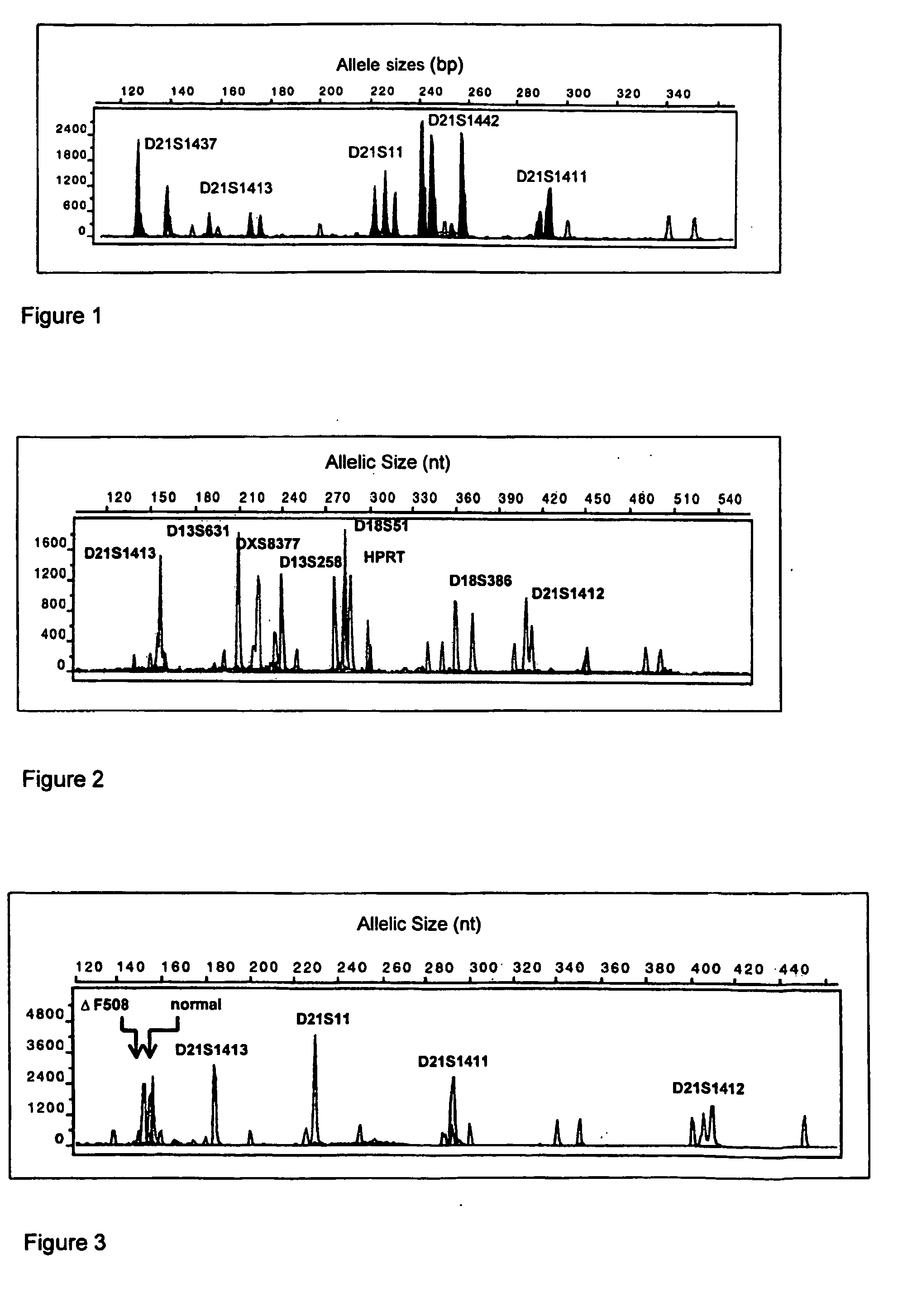Method of isolating cells and uses thereof
a cell and cell technology, applied in the field of non-invasive methods of retrieving and identifying cells, can solve the problems of high risk of congenital heart disease and leukaemia, high risk of miscarriage (1-2%), and samples obtained from other sources such as blood cannot be guaranteed, so as to facilitate cell identification and improve the yield of suspended single cells
- Summary
- Abstract
- Description
- Claims
- Application Information
AI Technical Summary
Benefits of technology
Problems solved by technology
Method used
Image
Examples
example 1
Diagnosis of Down Syndrome
[0174] (a) Collection and Preparation of Transcervical Cells
[0175] Collection of the transcervical cells from pregnant women during the first or second trimester is a similar procedure to a pap smear and involves direct aspiration of the cervical mucus, using a thin catheder (Aspiracath, Cook IVF), from the endocervical canal and the lower uterine pole. The tip of the catheder that contains the maternal mucus and transcervical cells is cut off into an eppendorf tube containing 0.5 ml of RPMI culture media and placed at 37° C. Gently the contents are mechanically removed from the inner tip of the catheder and suspended in culture media at 37° C.
[0176] (b) Identification and Isolation of Fetal Cells from Transcervical Samples
[0177] After collection, samples are treated with 0.5 ml of 20 mg / ml of N-acetyl-L-cysteine and further incubated with gentle shaking at 37° C. for 45 minutes. The entire sample is then washed twice in PBS before an incubation with 0....
example 2
Diagnosis of Down Syndrome II
[0185] (a ) The collection and preparation of transcervical cells is followed as described above in example 1.
[0186] (b) The Identification and Isolation of Fetal Cells
[0187] After collection, samples are spread onto slides and fixed in 100% ethanol. Immunohistochemistry is performed using first trimester fetal specific antibodies to identify the fetal cells. The slides are then dehydrated. Laser capture microdissection technology is used to remove positively stained cells from the slide onto membranes that can be directly transferred into PCR tubes.
[0188] (c, d and e) FL-PCR DNA fingerprinting for trisomy 21 and the analysis of FL-PCR products and diagnosis of aneuploidy is followed as described above in example 1
example 3
Simultaneous Diagnosis of Down Syndrome and Cystic Fibrosis DeltaF508 Mutation
[0189] (a & b) The collection and preparation of transcervical cells, and the identification and isolation of fetal cells is followed as described above in example 1.
[0190] (c) FL-PCR DNA Fingerprinting for Trisomy 21 and Cystic Fibrosis deltaF508 Diagnosis
[0191] The FL-PCR reaction is as described above with the following changes: the primer mix contains four informative chromosome 21 microsatellite markers along with the primer pair for deltaF508 mutation detection. Microsatellite markers outlined in Tables 2 & 3 are genotyped on parental genomic DNA to identify the heterozygous loci for incorporation into the DNA fingerprinting system. Final optimized primer pair concentrations are reaction and primer specific.
[0192] (d & e) Analysis of FL-PCR products and diagnosis of aneuploidy is as described above (see FIG. 3).
[0193] Finally it is to be understood that various other modifications and / or alterat...
PUM
| Property | Measurement | Unit |
|---|---|---|
| concentration | aaaaa | aaaaa |
| volume | aaaaa | aaaaa |
| volume | aaaaa | aaaaa |
Abstract
Description
Claims
Application Information
 Login to View More
Login to View More - R&D
- Intellectual Property
- Life Sciences
- Materials
- Tech Scout
- Unparalleled Data Quality
- Higher Quality Content
- 60% Fewer Hallucinations
Browse by: Latest US Patents, China's latest patents, Technical Efficacy Thesaurus, Application Domain, Technology Topic, Popular Technical Reports.
© 2025 PatSnap. All rights reserved.Legal|Privacy policy|Modern Slavery Act Transparency Statement|Sitemap|About US| Contact US: help@patsnap.com

